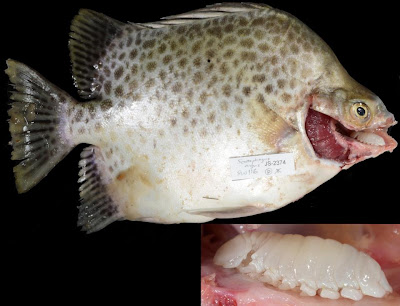We also had our FIFTH otter sighting for the Expedition, an exciting dredge and many other happenings as the last week of the Northern Expedition begins.
Dr Heok spotted the isopod and Dr Zeehan shows and explains it to the volunteers. The volunteers are morbidly fascinated by this living horror.
Here's the professional scientific photo of the fish with a cut away showing the isopod. I think it looks even more gruesome this way! According to the Raffles Museum News post: "The parasitic isopod lives within the mouth of the spotted scat. It has eaten away the scat's tongue (!) and has lodged itself in the tongue's place. No one really knows what the isopod/tongue lives off. Some studies suggest that they feed off the animals the fish eats; other studies suggest that they are blood drinking mouth leeches within the fish." Super icky!
 |
| Photo by Raffles Museum on facebook. |
 |
| Heok annoys Tommy by trying to take a photo of him fishing. |
Ywee Chieh is still hard at work at the Cryopreservation Station, which is cool in many senses of the word. Today there was a great article about the importance of tissue banks in the New York Times. It explains why such collection is vital and I'm glad it's being done during this Northern Expedition.
The lab is really busy as the work week begins. The ladies from Malaysia who specialise in seaweeds arrived recently and are hard at work. I learnt today that there are marine fungi! Which the ladies are interested in. I try to find some for them during our field trip.
Our local guidebooks are regularly used by the scientists to figure out some of our finds. Here Dr Helen is looking at the BP-Science Centre "A guide to common marine fishes of Singapore".
Later in the morning, I had a little splash around the back mangroves near OBS to get samples for the volunteers to work on. The tide was high and there were lots of little fishies among the mangrove roots. The water was relatively clear!
Dr Heok explains more about the fishes that a fisherman engaged by the Expedition has brought in. He found the isopod in one of them.
In the afternoon, the dredge arrives. Today it is full of marvelous animals. Like these huge sea stars that were crawling with commensals!
The dredge samples also included sea fans, some corals, more big sea stars, pretty pebble crab and even delicate bryozoans. The team have their hands full sorting them out.
As the Expedition comes to a close, it's time to get all our specimens in order. Here's a huge pile of sponges that have been found.
Some of the amazing variety of worms that have been found so far. The volunteers are helping to sort out and preserve these worms.
Besides squishy small stuff, the team have also sighted interesting animals in our mangroves. Such as this pretty snake that Kwan Siong saw during a night trip yesterday.
My friend Li San from Outward Bound Singapore, who has long been supportive of collaboration and cooperation with the blue groups, finally managed to stop by the Expedition. Dr Daphne kindly shows her some nematocysts of sea anemones while I brought her around to see the stations. Li San has been instrumental in introducing OBS instructors to nature awareness with the Naked Hermit Crabs. And she is the OBS lead in the International Coastal Cleanup Singapore effort.
While waiting for the field trip to start, I helped to clean some Velcro crabs in preparation for photography. When I finished cleaning a crab and asked for another, Tommy gave me this lump. It was a trick! There was no crab in it, just an ascidian and fluffy stuff. I can see how the crab's disguise protects it!
All too soon, it was time again for another field trip. When we met up with Pei Yan at Punggol, she said she saw a pair of otters while waiting for us at the jetty! Wow! This really shows that we can see a lot of marine life if we spend more time on the sea shores!
Today we visit a remote corner of Sungei Buloh Wetland Reserve. We go by the back gate to avoid scaring the birds and for a shorter walk to the site.
Almost as soon as we arrive, Pei Yan finds lots of 'spotty' sea anemones.
And starts collecting them from really hard wood where they are often found.
This area has vast mudflats! Yen-ling and Han Chong have found the sea anemone 'Bill' one of the key unidentified animals in the Mega Marine Survey.
We are on the look out for the crocodile, but sadly, we didn't see any on our trip.
At the end of the trip, we have a good scrub in the runoff at the sluice gate. Otherwise the bus will not let us back on.
It's been another exhausting but exciting day. Learning and discovering so much more about our shores!





















No comments:
Post a Comment